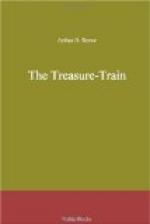The field appeared halved. He made an adjustment and at once the field of vision appeared wholly the same tint. When he removed the tube it was dark.
“If a liquid has not what we call rotary power both halves of the double disk appear of the same tint,” he explained. “If it has rotary power, the halves appear of different tints and the degree of rotation is measured by the alteration of thickness of this double quartz plate necessary to counteract it. It is, as I told Mr. Jameson early to-day, a rather abstruse subject, this of polarized light. I shall not bore you with it, but I think you will see in a moment why it is necessary, perhaps why some one who knew thought it would never be used.
“What I am getting at now is that some substances with the same chemical formula rotate polarized light to the right, are dextro-rotary, as, for instance, what is known as dextrose. Others rotate it to the left, are levo-rotary, as the substance called levose. Both of them are glucose. So there are substances which give the same chemical reactions which can only be distinguished by their being left or right rotary.”
Craig took a bit of crystalline powder and dissolved it in ether. Then he added some strong sulphuric acid. The liquid turned yellow, then slowly a bright scarlet. Beside the first he repeated the operation with another similar-looking powder, with the identical result.
“Both of those,” he remarked, holding up the vials, “were samples of pure veratrine, but obtained from different sources. You see the brilliant reaction—unmistakable. But it makes all the difference in the world in this case what was the source of the veratrine. It may mean the guilt or innocence of one of you.”
He paused, to let the significance of his remark sink in. “Veratrine,” he resumed, “is a form of hellebore, known to gardeners for its fatal effect on insects. There are white and green hellebore, Veratrum alba and Veratrum viride. It is the pure alkaloid, or rather one of them, that we have to deal with here— veratrine.
“There are various sources of veratrine. For instance, there is the veratrine that may be derived from the sabadilla seeds which grow in the West Indies and Mexico. It is used, I am informed, by the Germans in their lachrymatory and asphyxiating bombs.”
The mention of the West Indies brought, like a flash, to my mind Sandoval and Senorita de Leon.
“Then, too,” continued Kennedy, “there is a plant out in our own Western country, of which you may have heard, known as the death camas, very fatal to cattle when they eat it. The active principle in this is also veratrine.”
I began to see what Kennedy was driving at. If it were veratrine derived from death camas it would point toward Page.
“Abderhalden, the great German physiological chemist, has discovered that substances that once get into the blood produce specific ferments. Not long ago, in a case, I showed it by the use of dialyzing membranes. But Abderhalden has found that the polariscope can show it also. And in this case only the polariscope can show what chemistry cannot show when we reach the point of testing Senor Barrios’s blood—if that becomes necessary.”




